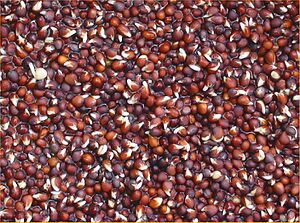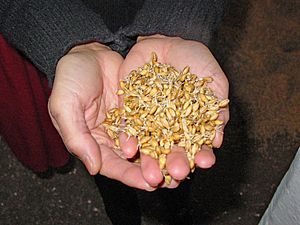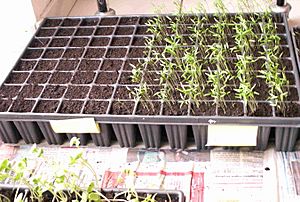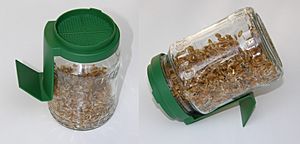Germination facts for kids

Germination is when a spore or seed begins to grow into a new plant. It's a key process in botany, which is the study of plants. When a spore or seed germinates, it usually forms a tiny shoot or seedling. For fungi, it grows into a hypha, which is like a tiny thread.
Spores and seeds are different. Spores are like tiny reproductive cells, often found in simpler plants like mosses and ferns, and also in fungi. They are very small and don't live long. Plants that use spores make huge numbers of them, hoping that a few will find the right conditions to grow.
Seeds are more complex. They contain a tiny plant called an embryo, a food supply (called the endosperm), and a protective outer layer. Plants that make seeds include Gymnosperms (like conifer trees) and flowering plants. Seeds can last much longer than spores, sometimes even hundreds of years! Seed-bearing plants put a lot of energy into making their seeds, and they have developed clever ways to spread them, not just relying on the wind.
Seeds won't germinate until all their needs are met. These needs can be different for each species of plant.
- The dormancy period must be over. Dormancy is like a resting phase for the seed. Each plant species has its own resting time, and the seed won't sprout until this period ends.
- Their hibernation must be over. This "hibernation" ends when things in the environment, like temperature or water, tell the seed it's time to grow. Sometimes, a seed needs a long cold spell or even fire to trigger germination.
Fruits are basically seeds with extra layers from the flower. So, their germination needs are the same as those of seeds.
Contents
How Seeds Begin to Grow

Germination is when the tiny plant inside a seed starts to grow, forming a seedling. It's also when the seed's internal systems "wake up," leading to the first root (radicle) and shoot (plumule) appearing. A seed from a vascular plant is a small package made inside a fruit or cone. It forms after male and female plant cells join together. Most fully grown seeds have an embryo (the baby plant) and some stored food, all wrapped in a seed coat.
Some seeds don't have an embryo inside; these are called empty seeds and will never germinate. Dormant seeds are ripe seeds that don't sprout because outside conditions stop them from starting their growth processes. When the conditions are just right, the seed begins to germinate, and the embryo starts to grow into a seedling.
What Seeds Need to Germinate
For a seed to germinate, both internal (inside the seed) and external (outside the seed) conditions are important. The most important external factors are the right temperature, water, oxygen (or air), and sometimes light or darkness. Different plants need different things for their seeds to sprout successfully. This often depends on the type of seed and the natural conditions of the plant's home.
- Water is essential for germination. Mature seeds are often very dry and need to soak up a lot of water compared to their dry weight. This water helps the seed's cells "wake up" and start growing. Most seeds need enough water to get damp, but not so much that they are completely soaked. When a seed takes in water, it's called imbibition. This causes the seed to swell and its protective coat to break open. Most plants store food like starch, proteins, or oils inside their seeds. When the seed takes in water, special chemicals called hydrolytic enzymes become active. These enzymes break down the stored food into useful chemicals that the growing embryo can use. After the seedling grows out of the seed coat and starts making roots and leaves, its stored food runs out. At this point, the seedling starts making its own food through photosynthesis, so it needs a steady supply of water, nutrients, and light.
- Oxygen is needed by the germinating seed for its metabolism. Oxygen is used in aerobic respiration, which is how the seedling gets most of its energy until it grows leaves. Oxygen is a gas found in the air within soil spaces. If a seed is buried too deep or the soil is waterlogged, it might not get enough oxygen. Some seeds have hard outer coats that stop oxygen from getting in. This causes a type of dormancy that only breaks when the seed coat wears away enough to let air and water in.
- Temperature affects how fast a seed's cells work and grow. Seeds from different plant species, and even from the same plant, can germinate over a wide range of temperatures. Seeds usually have a specific temperature range where they will sprout; they won't grow if it's too hot or too cold. Many seeds sprout best at temperatures around 60-75 F (16-24 C), which is about room temperature. Others sprout just above freezing, and some only sprout when temperatures go from warm to cool. Some seeds need to be exposed to cold temperatures (vernalization) to break their dormancy. For example, seeds that need a cold winter won't sprout until they take in water in the fall and experience cooler temperatures. This is called cold stratification. Some seeds will only sprout after being heated by a forest fire, which cracks their hard seed coats.
Most common vegetables grow best between 75-90 F (24-32 C). However, many (like radishes or spinach) can sprout at much lower temperatures, even as low as 40 F (4 C). This allows them to be grown from seeds in cooler places. If temperatures are not ideal, fewer seeds will sprout, and it will take longer.
- Light or darkness can also trigger germination. This is another type of dormancy. Most seeds aren't affected by light or darkness. But many seeds, especially those from forest plants, won't sprout until an opening in the tree canopy lets enough light reach the ground for the seedling to grow.

Sometimes, seeds need a process called scarification. This is when the seed coat is weakened, mimicking natural events. In nature, some seeds need the heat of a fire or a long soak in water to sprout. Others need to pass through an animal's digestive system, which helps to weaken the seed coat enough for the tiny plant to emerge.
Seed Dormancy
Some live seeds are dormant, meaning they are resting. They need more time, or specific conditions, before they will germinate. Seed dormancy can be caused by different parts of the seed, like the embryo or the seed coat. Breaking dormancy often involves changes inside the seed, usually when it has absorbed water. Plant hormones play a role: abscisic acid stops germination, while gibberellin helps end dormancy. For example, in brewing, barley seeds are treated with gibberellin to make sure they all sprout evenly to produce barley malt.
Growing into a Seedling
Some people say that germination ends when the first root (the radicle) appears. After this, the plant enters a stage called "establishment," where it uses the food stored in the seed to grow. Both germination and establishment are very important times in a plant's life. During these stages, young plants are most easily hurt by injury, disease, or not enough water. Many plants produce a huge number of seeds because so many might not survive to become established plants.
Germination Rate and Capacity
In farming and gardening, the germination rate tells you how many seeds from a certain plant type or batch are likely to sprout over a period of time. It's usually shown as a percentage. For example, an 85% germination rate means that about 85 out of 100 seeds will probably sprout under the right conditions. Knowing the germination rate helps farmers and gardeners figure out how many seeds they need for a certain area or number of plants.
For scientists, "germination rate" can also mean how quickly the germination process finishes after planting. On the other hand, germination capacity refers to the total number of seeds in a group that are able to germinate.
Images for kids
See also
 In Spanish: Germinación para niños
In Spanish: Germinación para niños






